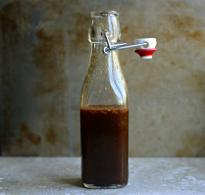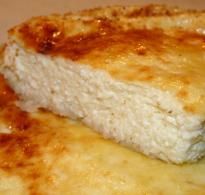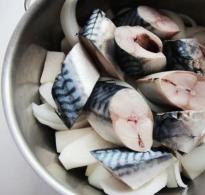How long can mushrooms be stored in the refrigerator. Freezing champignons in a home refrigerator: the best ways
Champignon is a perishable product, so its safest and most rational use is to sell it on the day of harvest, and eat it on the same day or the next.
However, such a quick sale of the product and its same rapid consumption are not always possible and expedient. With a general lack of protein, champignons with an intensive method of growing them could make a significant contribution to replenishing the protein deficiency. Therefore, the question arises of the need to develop rational methods for storing champignons, and first of all, storing fresh fruiting bodies, since it is they, and only then canned food, dried mushrooms, etc., that attract the attention of the buyer.
Practitioners of champignon growers have long noticed that when stored at normal room temperature or even at a slightly lower temperature compared to 20-22 ° C, champignon fruiting bodies quickly lose weight and deteriorate: they soften, turn brown or turn brown, caps open, a private cover is torn. The fruiting bodies of the first wave are especially sensitive to storage at high temperatures. Therefore, already at the very first stages of the development of champignon growing, it became clear the need to store harvested champignons, the sale of which was delayed for some reason even less than a day, in rooms with low temperatures or in refrigerators. In the pre-war period in our country, fruit bodies collected in sieves or shredded baskets were stored in rooms where the temperature did not exceed 7 ° C. However, such storage turned out to be irrational, since fruit bodies lost an average of 2 -3% of its mass. In addition, temperatures within 4-6 ° C, according to M. A. Panov, as well as temperatures within 3-5 ° C, filed by K. V. Rybkina, ensure the preservation of fruiting bodies during the day; after this period, even at the indicated temperatures, the mushrooms begin to lose their commercial qualities.
To establish favorable temperatures for more or less long-term storage of champignon fruiting bodies, N. G. Gromov carried out a lot of research work. Using powerful commercial refrigerators available at the Exhibition of Achievements of the National Economy in Moscow, he laid the foundation for experience in long-term storage of champignons at a temperature that ranged from 0 to 5 ° C and air humidity of 80-85%. It turned out that even when stored at low temperatures (from 0 to 5 ° C), there was a decrease in the mass of mushroom fruiting bodies by an average of 0.9% per day. Nevertheless, the storage of harvested mushroom products at a low temperature in special refrigerators is the most common in all countries producing mushrooms.
In Poland, it is customary to store fresh fruit bodies of champignons in refrigerated chambers measuring 2 X 2 X 3 m at a temperature of 4 ° C. Up to 1000 kg of champignons are placed in such a chamber. In other countries (France, England, the Netherlands), lower temperatures are adopted for storing fresh fruiting bodies. In England, for example, champignons are stored at a temperature of 2 ° C and a relative humidity of 85%. The same storage temperature for freshly harvested champignon fruiting bodies, regardless of their destination - whether they are sold fresh or for processing at a freeze-drying plant - is adopted in France. Here, too, champignons immediately after harvest are placed in special cold chambers or in appropriately equipped quarries, where the temperature is maintained at 2 ° C.
Of undoubted interest is the approach of French specialists to solving the issue of storage facilities. Unlike most champignon farms in different countries, where fresh fruiting bodies are stored in commercial refrigerators after harvesting before being sold, French farms that grow champignons in quarries, here in the quarry tunnels create rooms for storing fresh products. The champignon farm, located in Chassey, 6 km from Saumur, has two refrigeration tunnels in its quarries for growing champignons, each of which is designed to store a daily volume of fresh product. Each of these tunnels has a volume of 100 m 3 and can accommodate 10 tons of champignon fruiting bodies in an appropriate package. To reduce the thermal conductivity of the tunnel walls, the construction uses rigid insulating panels connected with grooves and spikes. The ceiling of the tunnel consists of the same rigid panels. The original issue was resolved. installation of refrigeration equipment - refrigeration units are suspended from the ceiling. If repairs are needed, they can be easily dismantled. The tunnels are equipped with automatic vertical doors and mechanisms that allow pallets with packed fresh mushrooms to be moved. Such an arrangement of cooling tunnels allows them to maintain a constant temperature of 2 ° C. Two similar tunnels are available in the quarries of the Blanchot company for storing fresh product intended for processing at the freeze-drying plant. It also maintains a temperature of 2°C.
In the Netherlands, short-term (no more than a day) storage of fruiting bodies is carried out in refrigerators at a temperature of 2-3 ° C. For longer storage (6-7 days), temperatures of 0-2 ° C and relative humidity of at least 80% are favorable. It should be noted that in the Netherlands, a lot of research work is currently underway to improve the method of storing fresh champignon fruiting bodies at low temperatures: the effect of processing at low temperatures on the subsequent keeping quality of fruiting bodies is being studied; various races of champignon are tested in order to select those that do not receive significant changes in commercial and taste qualities at low temperatures; new improved refrigerators are being designed for long-term storage of mushroom fruiting bodies.
The same work to find new more reliable ways of long-term storage of fresh fruiting bodies is being carried out in other countries - large producers of champignons. As a result, as new storage methods that increase the keeping quality of mushrooms without reducing their presentation and taste, the use of a nitrogen atmosphere and vacuum, radio irradiation is proposed, although there are significant objections to the latter method regarding its application to food in general and to champignons in particular. More promising and safer for the health of the consumer and providing a really long-term storage of fresh fruit bodies of champignons is a quick deep freezing of the product, which has found quite a wide application in England, Canada and a number of other countries. This method ensures even distribution of the product over the seasons, delivering selected small, freshly formed champignon fruiting bodies (in the bud stage) to the distribution network not only in autumn and winter, but also in the hotter months of the year. During this period, fresh fruiting bodies, ripening in champignons, increase in weight and size, deteriorate in appearance, especially in those farms where they are grown under uncontrolled conditions. One of the first enterprises for rapid deep freezing of fresh champignons was established in Canada, in the province of British Columbia.
Freshly harvested fruiting bodies carefully processed in accordance with the requirements of the standards at the factory are placed in wire baskets made of non-oxidizing metal, which are immersed for several minutes in baths with a special chemical solution. From here, the mushrooms enter the machine, which automatically cuts the fruiting bodies into slices along their longitudinal axis. The machine consists of containers (bowls) filled with the same chemical solution that is found in baths, and a series of razors. At the back there is a chute that allows the razors to pass through the entire space of the bowl and cut the fruiting bodies floating in the solution in one direction. After this operation, sliced mushrooms enter the conveyor and are fed into the air freezing tunnel. Here, the mushrooms are kept for 11 minutes at -20°C in a stream of cold air that circulates in a tunnel of special fans and refrigerator coils. The product comes out of the tunnel ready for packaging, and (which is very important for the presentation of the product and when using it for cooking) each slice is frozen separately. After freezing, the slices are packaged in specially sized cartons containing about 2 kg (7 oz) of product. The boxes filled with slices are conveyed to the sealing machine. When the box enters the machine, the lid, the function of which is performed by the side folding blades of the box, is closed by guiding mechanical devices. The high frequency radio waves then activate the adhesive previously applied to the blades of the carton, and as a result, the carton is hermetically sealed. Completely finished packaged products enter the basement of the enterprise, where refrigeration units maintain a temperature of 0 ° C, and are stored there for the required time (from several days to several months) before being sent for sale. In the same way, not only individual slices, but also whole fruiting bodies of champignons can be frozen. So that they are well saturated with a chemical solution, holes are pierced in them. However, O. Belisle notes that in Canada and many other countries of the world where Green Pony frozen mushrooms are sold, buyers prefer sliced mushrooms, as this reduces one operation during cooking.
It should be noted that champignons thawed at home do not differ in any way from fresh ones either in the whiteness of the pulp, or in its elasticity, or, most importantly, in taste. There are other currently very common methods of storing champignons - canning, drying, including freeze-drying, etc., however, the final product obtained as a result of these methods of processing champignons still differs significantly from fresh fruiting bodies and in appearance appearance and chemical composition.
It is advisable to dwell on the influence of various types of containers (packaging) on the safety of champignon fruiting bodies, since this aspect of storage is currently receiving considerable attention in practice and scientific research. In modern industrial-type champignon farms, fruiting bodies, as already noted, are packed in various containers made of new materials: plastics, synthetic fibers, specially processed cardboard, etc. At the same time, inside such containers, fruiting bodies are often wrapped in films of various types, which allows achieve a longer shelf life compared to previously used materials - ordinary cardboard, wood, etc.
In many research centers for the cultivation of champignons, work is underway to select the optimal combination of new materials for storing fruiting bodies. R. Nichols and D. B. W. Hammond tested three types of containers made from aged, compressed fiber, and waxed board. Freshly picked mushroom fruiting bodies at the bud stage were placed in 250-gram boxes made of these materials. In half of the boxes from each material, the fruiting bodies were additionally wrapped with a synthetic film. After that, the same number of boxes made of aged, compressed fiber and waxed cardboard with mushroom fruiting bodies, wrapped or not wrapped in film, were placed in refrigerators at a temperature of 2 ° C and a relative humidity of 85%, where they were stored for 5 days. After this period, champignons from all boxes of different materials without a film and from a part of boxes of different materials with a film were subjected to a study for keeping quality. The remaining boxes with champignons wrapped in foil and kept in the refrigerator at 2°C for 5 days were divided into two groups. The boxes of the first group were taken out of the refrigeration chamber and kept unopened for 2 days at 18°C. The boxes of the second group were kept for 2 days at the same temperature, but opened.
The results of the experiments for containers from all three tested materials show the need for additional wrapping of the fruiting bodies with synthetic film, since in the variant of the experiment, where the mushrooms were wrapped during the period of storage in the refrigerator at 2°C and then during storage outside the chamber film, they have the smallest weight loss. The most promising of all three materials tested was a non-absorbent plastic - styrene. It was in styrene boxes in all variants with and without film wrapping that mushroom fruiting bodies retained their original mass better.
Data on the change in mass of mushrooms in boxes of different materials, aged for an additional two days at 18°C, emphasize the need to keep the package closed even under home storage conditions without refrigeration. The packaging should be opened only immediately before using the mushrooms for cooking, otherwise weight loss is inevitable and, in addition, deterioration in the appearance of the fruiting bodies, manifested in the browning of their caps and legs.
Another experiment similar to the one described above was carried out. Mushroom fruiting bodies were placed in boxes of all three materials, wrapped in film and without it, and kept for 3 days at a temperature of 18°C and a relative humidity of 60%. Then, a part of the capsules from all three materials under study, in which the fruiting bodies were wrapped in a film, were opened and kept for another 2 days at the same temperature and relative humidity.
This experience also confirmed the conclusion made by the authors from the data of the previous experiment, that smaller weight loss in the container of all three tested materials is observed in cases where the fruiting bodies are wrapped in film. And when stored at a high temperature, which is 18 ° C for the fruiting bodies of champignons, containers made of styrene proved to be better than others, where even under these conditions the fruiting bodies retained their original weight better.
In cold stores (2°C), compressed fiber and waxed cardboard containers resulted in a loss of 9% of the wet weight of the fungus, while non-absorbent styrene containers only lost 7%; Accordingly, at 18°C, mushrooms in a compressed fiber container lost about 37% of their wet weight, while in a styrene container, only 27%.
The choice of products is a responsible occupation. It is important for housewives to know not only how to choose the right mushrooms in a store or market, but also how to store fresh champignons. They are widely distributed around the world and have earned the love of both famous chefs and ordinary housewives. The second name of these mushrooms is stoves. Light refined taste and versatility are their undeniable advantages. They are used for cooking first courses, pastries, side dishes, pickles and salads. They are always available on store shelves at any time of the year.
It is advisable to cook fresh mushrooms immediately after purchase - this will help save the maximum amount of vitamins and nutrients contained in the product. Not everyone knows how much benefit stoves bring to the human body:
- strengthening bones and preventing the development of osteoporosis (vitamin D2);
- improvement of the neuromuscular system (sodium);
- strengthening the heart muscle (potassium);
- normalization of metabolism (phosphorus).
The longer you store mushrooms, the less useful they will retain. If after the purchase you do not have the opportunity to cook them right away, you can save the ovens in the refrigerator. Remember it's small. It depends not only on conditions and temperature, but also on their freshness.
How to choose fresh mushrooms?
The basic rule for choosing fresh mushrooms is to look at the hat. It should be pinkish or beige in color. There should be no stains or cuts. If the cap has darkened, the mushroom is overripe. Aging time affects softness. If the mushroom is beautiful and fresh on top, look under the hat. Its edges should adjoin the leg. If the hat began to wrap up and dark spots are visible under it, then the mushrooms have been stored on store shelves for a long time.
Lightly press down on the leg. It should be elastic and not have voids. Smell the stoves - they should smell like forest and fresh mushrooms. If you feel a sourish unpleasant odor, they have been stored at the seller for a long time. The hat should be elastic and dense. If you feel mucus on its surface or it has lost its elasticity, there is no doubt that the expiration date of such a product has long expired.
When choosing products on the market, you have the opportunity to make sure that each individual mushroom is fresh, no matter how many kilograms you buy. In supermarkets, under fresh mushrooms, you can find spoiled ones. This will affect the shelf life of the entire tray.

How to store champignons?
The question of how many days fresh cookies can be stored in the refrigerator is especially important. This affects not only their appearance, but also human health. The danger is darkened champignons, which have been stored for a long time. Experts say that the optimal shelf life in the refrigerator is a day. Sometimes this time is not enough to have time to cook a mushroom dish.
Some experts say that stoves are stored for up to 3 days. If you follow all the storage rules, then the mushrooms will “live” in the refrigerator for a week or even 10 days (provided that a very fresh product is purchased).
It is worth taking into account the basic rules for storing champignons.
- The optimum temperature is 2-4 °C. If the temperature in the refrigerator is from 0 to 2 ° C, then the mushrooms can be stored for 15 days.
- Mushrooms must be hermetically packed: placed in a closed container, a plastic bag or wrapped in cling film. Store packaging always indicates how long the product can be stored. Follow these directions.
- Do not wash and clean ovens before storing them in a refrigerator. They will immediately darken, become covered with a slippery film and quickly disappear.

Other ways to "prolong the life" of champignons
- freezing;
- pickling;
- drying.
You can freeze raw, fried or boiled pecherits. In this case, the shelf life will increase to 6 months. Dried mushrooms are stored for a year. But not all dishes can be prepared from such a product. It is suitable for making soups and seasonings. Marinated pecherits can be stored for up to 6 months thanks to the vinegar that is part of the marinade.
Each housewife is obliged to know how much this or that product is stored. Not only the quality of the dish depends on this, but also the health of each family member.
Champignons are the safest mushrooms. They can even be consumed fresh. These mushrooms in the wild grow well in pastures, as they love manure-fertilized soil. On an industrial scale, they are grown in special greenhouses. If desired, champignons can be grown in your country house or in the basement.
After harvesting a rich harvest, you should also think about how to properly store champignons at home so that they do not lose their external attractiveness, but at the same time retain the entire set of useful substances.
How to properly store mushrooms
Mushrooms should be stored in a refrigerator. Do not wash the mushrooms before storing them as they will darken quickly.
Storage temperature
The optimum storage temperature for champignons is 5-7 degrees.
Store mushrooms in a covered container so they don't lose moisture. If you use plastic bags for storage, once every 3 days, open them for ventilation, otherwise the condensate that will inevitably be present will lead to decay of the mushrooms.
Mushrooms can be stored in the refrigerator without any container. But in this case, the shelf life of mushrooms will be significantly reduced. However, it is not at all necessary to store mushrooms fresh. Many people prefer to freeze or pickle mushrooms. In this case, the mushrooms can be left in the refrigerator for the whole winter.
To marinate mushrooms, first rinse them, then cover with water and boil in the marinade. At the very end, add vinegar. Then put the mushrooms in steamed jars and roll them up. You can store pickled champignons in glass jars both in the refrigerator and at room temperature, but in the latter case, the mushrooms will have to be consumed in the coming months.
Now let's see if it is possible to store champignons in the freezer?
Indeed, many people prefer to freeze mushrooms. Here, too, there are several options. Mushrooms can be frozen fresh, boiled or fried.
In the first case, the mushrooms should be wiped with a cloth, packed in containers and frozen. If the mushrooms are large, you can cut the mushrooms before freezing. Washing and soaking champignons in this case is prohibited.
If you decide to freeze boiled mushrooms, then before heat treatment, first rinse them, cut into slices, and then boil in salted water until tender. Drain the broth, dry the mushrooms slightly, and then arrange in bags or containers and freeze. All packages must be tightly closed.
Fried champignons are also suitable for freezing. To do this, rinse the mushrooms, cut into pieces and fry in a small amount of oil. Cool the mushrooms, arrange in bags and freeze.
Some prefer to dry mushrooms. Although in this case, the mushrooms become tasteless and lose all gastronomic appeal. Store dried champignons, like all mushrooms, in paper bags or canvas bags in a dark, well-ventilated place.
How long to store champignons
For many, the question remains how long champignons can be stored. In fact, it all depends on how the mushrooms are processed. Surprisingly, in each of the above storage methods, the shelf life of champignons is different.
- So, fresh champignons wrapped in polyethylene can be stored in the refrigerator for 7 days, while unpacked champignons lie only 3-4 days.
- Pickled champignons can be stored at room temperature for 2-3 months, while mushrooms can stand in the refrigerator for a year.
- The shelf life of dried champignons is 8-12 months.
- When fresh mushrooms are frozen, the shelf life of champignons in the freezer is only 40 days, while fried and boiled champignons can be stored frozen for 6 months.
Mushroom pickers are sure that the best thing about mushrooms is the process of picking them. Many enjoy the immediate process, but there are those who prefer the finished product. For this, fresh champignons, oyster mushrooms and other exotic mushrooms appear on store shelves.
What are mushrooms?
This agaric mushroom got its name from the French word, which, translated into Russian, simply means “mushroom”.
The structure of champignon does not differ from other spores of this genus. A rather massive hat of various sizes of a rounded shape flattens out from the moment of growth. So you can judge the age of the fungus - the older it is, the more flat the hat. A rather dense, but short leg has a “coverlet” that frames it at the point of attachment to the hat. The leg is rarely loose or hollow inside.

Inside the cap are plates, dense and even. They have different colors throughout the life of the fungus. So, in young champignons, the plates are light, slightly pink, then they darken, acquiring an almost black color. This is also an indicator of the youth of the fungus.
When the cap is broken, you can see the pulp of the champignon. It is light, slightly pinkish. It has a pronounced mushroom taste.
Prevalence
True mushroom pickers do not recognize champignons as mushrooms. After all, you will not find them in the forest, but you can easily find them on the shelves of the supermarket. Although true gourmets still manage to find this mushroom on their own.
Mushrooms are saprophytes, which means they will grow in nutrient-rich soil. It can be rotten tree bark, humus or manure.
There are five main types of this mushroom:
- Growing only in the forest.
- Growing only among herbs.
- Saprophytes of open spaces.
- Desert (halophytes).
- Mixed (growing among grasses and in open spaces).
Most often, this agaric can be found in Eurasia, Africa and Australia.
Meaning
To date, champignons are the most common mushroom eaten. The only species that is poisonous is the motley, or yellow-skinned, champignon. Its use is dangerous to health. All other lamellar species of this fungus can be consumed in all forms.
Saprophyte received such widespread distribution due to its taste, cheapness and ease of preparation, not to mention how long champignons are stored in the refrigerator.
History of mushroom consumption
Champignon mushroom has been known to the French since the 16th century. As a matter of fact, it got its name at this time. Historians believe that the villagers used mushrooms for food before that time, but this was not indicated in the annals.
Many restaurants in medieval France sought to purchase this fresh and exquisite product. Chefs of the world created culinary masterpieces from champignons, for which rich people paid very large sums.
But today champignon is the most common and inexpensive among mushrooms. It grows in more than 70 countries, and some grow it on special farms and supply it to the markets (Belgium, the Netherlands).
Champignon can be bought canned, pickled, frozen and fresh, as well as whole or in pieces.
You can buy such a product at any time of the year, because it is grown artificially, in special greenhouses.
Useful properties of champignons
The biggest positive feature of this product can be called contained in it. Due to this, mushrooms prevent bone fragility and the development of osteoporosis.
No matter how long the mushrooms are stored in the refrigerator, they will still retain their beneficial properties.
Mushrooms of this species contain sodium, which has a beneficial effect on neuromuscular conduction, the heart and blood vessels.
Many argue that mushrooms contain substances that help stop the blood, and also have a beneficial effect on the digestive system.
However, do not get carried away with such products. After all, all mushrooms are heavy food for the body. Their digestion requires a large amount of enzymes and energy.
Many housewives know that not only their taste, but also the digestion time will depend on how much champignon mushrooms are stored in the refrigerator. The younger and fresher the product, the easier it is for the body.
An interesting fact is that studies conducted in 2009 proved that the periodic use of these lamellar saprophytes helps to reduce the risk of developing oncology.
Harm of mushrooms
Mushrooms contain the substance fungin, which destroys the mucous membrane of the stomach and intestines, thereby causing irreparable damage to health.
The use of this product is also contraindicated for children, because their digestive system cannot cope with such a heavy product.

How many days champignons are stored in the refrigerator depends on their digestion. A product that has undergone heat treatment is best eaten immediately. The longer it is stored, the worse it is digested.
Storage of champignons
Any mushroom is a perishable product, which is why these spore plants are best eaten within 2-3 days after harvest. Of course, it is very difficult to achieve such deadlines, so manufacturers use various tricks, offering the product in frozen, canned and pickled form.
The answer to the question of how long fresh champignons are stored in the refrigerator will be a period of 1 to 3 days after harvest.

How to store mushrooms in the refrigerator
First and most important - do not wash! After rinsing with water, the mushroom darkens and must be cooked immediately. It is best to put the product in a paper bag and place it in the vegetable compartment. In this case, the temperature in the refrigerator should not be higher than 3 degrees. So you can keep a healthy mushroom for up to 5-6 days from the date of collection.
Very often, housewives are interested in the question of how long champignons are stored in the refrigerator in a plastic bag? It should be noted that this type of storage is not welcome, because vacuum-packed mushrooms "do not breathe", which means they can quickly rot. In addition, condensate accumulates very quickly in polyethylene, which can lead to the formation of foreign substances in the dietary product. If you still had to store the mushrooms in a bag, then air them daily and try to cook them within 5-6 days.

For storage, it is necessary to spread the mushrooms in one layer, cover with paper or make holes in the cellophane. The best storage place is the vegetable compartment.
How long do fried mushrooms keep in the refrigerator?
After the product has undergone heat treatment, it must be consumed immediately. It is not recommended to store fried or boiled mushrooms in the refrigerator for more than 2 hours.

How long do marinated champignons keep in the refrigerator?
Various recipes for marinating champignons have been used for a very long time. This helps to keep the product in the refrigerator for up to a year, while it does not lose its taste. It is important to strictly adhere to the recipe.

Freezer storage
Freezing champignons is the most popular and convenient type of storage. In this case, the product can be consumed within 6 months. It is necessary to freeze the champignons in the portions necessary for cooking. Re-freezing is not allowed.
Some store mushrooms in the freezer in boiled form. This method is also acceptable. However, after cooking, be sure to rinse the mushrooms and remove excess moisture. The shelf life of boiled champignons in the freezer is 6 months.
Dried agaric mushrooms can be consumed throughout the year. To do this, the slices must be thin and well dried. Some are interested in how long champignons are stored in the refrigerator in dried form. In this case, a lower temperature will not extend the shelf life, but excess moisture can spoil the dried mushrooms. Therefore, dried champignons are best stored in a glass airtight container.
They can be different:,. Some housewives prefer them. It is very convenient, because it is always at hand. On any day, you can defrost a portion and cook a fragrant dish.
mushroom preparation
Before freezing in the freezer, they need properly prepare for it:
- For choosing only the freshest mushrooms, bright white, without dents and spots, medium size.
- should be washed thoroughly. Some housewives wash them thoroughly in cold water without cleaning them. Others recommend doing this in warm water: this will soften the hat and stem, which will help them clean up quickly.
- Pure mushrooms need to be dried: they are laid out for 20-30 minutes on a napkin until it completely absorbs water. It will turn out faster if each mushroom gets wet with a paper towel.
- Cut off the excess: the root system and darkened places.
Freezing fresh mushrooms
For those who decide to freeze for the first time, the question arises: is it possible to freeze them raw or do they need to be cooked somehow? Experienced housewives willingly harvest fresh mushrooms. It takes a minimum of time, and later you can cook any dish from them. Freshly frozen, they are stored for 1 year at a temperature of -18 ° C.
Whole
Clean, dried mushrooms are prepared for freezing as follows:
- If they are small, they can be sent to the refrigerator as a whole.
- Fans of stuffed mushrooms can only freeze the caps, carefully separating them from the legs.
- To begin, the mushrooms are placed in a clean food container, a plastic bag, or a ziplock bag.
- Remove the air from the bag, close it tightly and place it in the freezer.
- Whole mushrooms can be baked with fish or.

sliced
Usually chopped mushrooms are used more often than whole ones. When freezing this type of mushroom, you must:
- Washed champignons cut into equal slices.
- You need to freeze them not in bulk, but in a thin layer: frozen pieces are very fragile and can break. You can use a flat surface for this, such as a baking sheet, a piece of foil, or a cutting board.
- The surface with the laid out mushroom pieces is placed in the upper section of the freezer so that they freeze quickly.
- After a few hours, when they freeze, they can already be poured into one bag or container and sent back to the freezer.
- Such champignons are perfect for soup, mushroom sauce, as a filling for pies and a side dish for.
Did you know? For the first time, champignons were artificially grown in 1650 near Paris. After 100 years, a method for their year-round cultivation was developed.
Other freezing methods
How else can you freeze champignons at home so that it lasts all winter? Boiled and fried.
Boiled
Boiled mushrooms are prepared as follows:
- Fresh, washed mushrooms are laid out in a saucepan, poured with water, salted and put on fire.
- When they boil, boil for another 10-15 minutes.
- Then the boiled champignons are thrown into a colander so that the water is glass.
- When cool and dry, the mushrooms are poured into a storage container and put in the freezer.
- In boiled form, they are stored for six months.

fried
Even fried champignons can be frozen:
- To do this, prepared mushrooms need to be cut into slices and put on a preheated pan, greased with oil. Salt is not necessary.
- They should be fried over medium heat until the moisture is completely evaporated.
- You can bake them in the oven without oil.
- The cooled mushrooms should be transferred to a storage container and sent to the freezer, where they can remain for about 6 months.

How long are stored in the freezer
Mushrooms, like other products, have their own shelf life depending on storage conditions:
- mushrooms can lie open in the refrigerator for 3 days, then they darken, weather, it is no longer recommended to eat them;
- under cling film at the same temperature, the shelf life increases to 6 days, after which they become hazardous to health.
But frozen champignons can be stored much longer. At a temperature of -18 ° C, any mushrooms are stored until the next season, and at -20 ° C, they can lie longer. In the case of champignons, this is not necessary, since they are artificially grown and are available for sale for almost a year.
Usually frozen mushrooms are stored:
- fresh - 1 year;
- boiled and fried - half a year and longer.

How to defrost
In order for products to remain both tasty and healthy after freezing, they should be defrost properly:
- It is not necessary to defrost the entire batch of mushrooms, but only the necessary portion, because they cannot be re-frozen.
- The defrosting process should be gradual. Therefore, the right amount of champignons is transferred from the freezer to the refrigerator for several hours, preferably at night.
- Many dishes, such as soups and casseroles, do not need to be thawed for cooking.
Important! Mushrooms cannot be re-frozen, otherwise they will lose not only their shape, but also their nutritional value.







